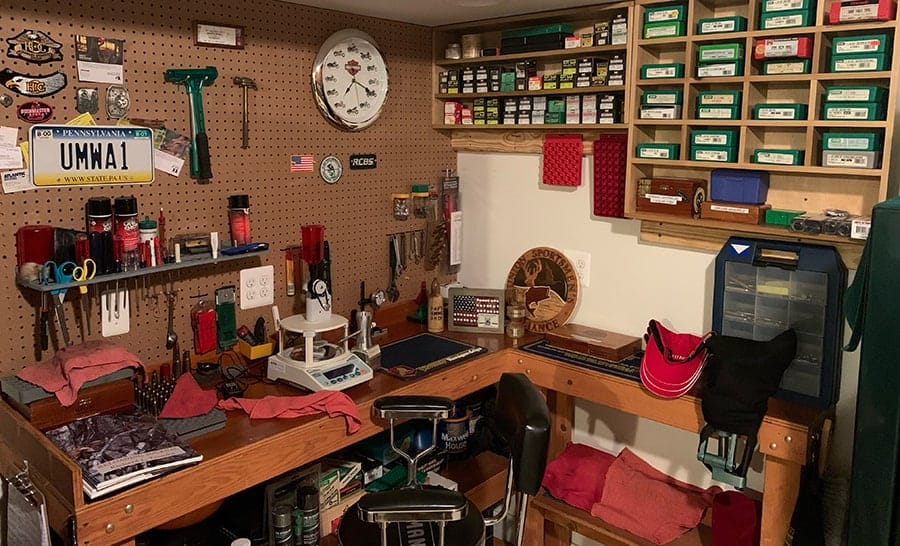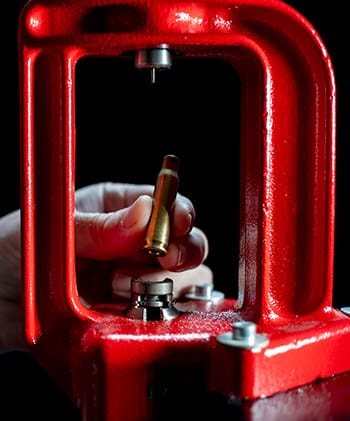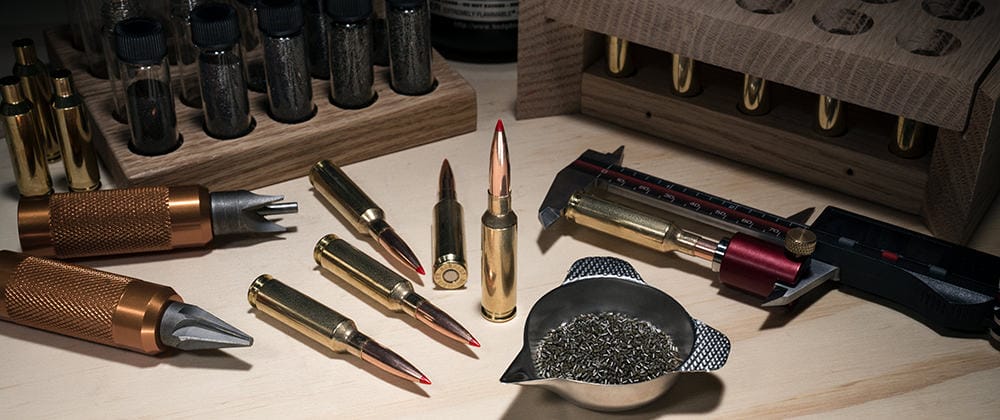The Case for Reloading Ammo
Reloading was Trumka’s time to relax and decompress
by Kurt Beckstrom
Reloading ammo isn’t for everyone. But if you have a do-it-yourself spirit and take pride in building something superior to what comes off a store shelf, there are many benefits to reloading ammo. We’ll share some of those as well as reloading ammo steps and tips on how to start reloading ammo yourself.
Rich Trumka’s Passion for Reloading
As president of the 12.5-million-member AFL-CIO, Richard Trumka was driven by a lifelong passion to ensure all workers have a good, safe job with fair wages, working conditions, and benefits. Though those responsibilities kept him incredibly busy, he also maintained an important balance. He believed strongly in making time for his family, spending time in the outdoors, and ensuring he had time for himself. Customizing his own handloads was a part of the time he reserved for himself.
“When Rich was building an addition onto his house, he was most excited about his basement reloading room,” said longtime friend Walt Ingram, USA director of union relations.
Trumka spent hours meticulously handloading round after round of ammunition for one of his own firearms or for one belonging to a friend or family member, according to those who knew him.
“He was a perfectionist with everything—casing, primer, powder, bullets,” said close friend Richard Barchiesi, AFL-CIO special assistant to the president. “When he bought a new rifle, he’d make five rounds of each and then test the loads to see which performed best, taking measurements and notes on each group. Then, he’d go back to the drawing board if the results weren’t what he wanted.”
Trumka’s desire to create perfect handloads stemmed from his keen interest in long-range shooting. “He didn’t want to be a decent long-range shooter,” explained Ingram. “He wanted to be the best.”

Rich Trumka’s reloading room.
Benefits of Reloading Ammo
While many handloaders like Trumka seek to develop a bullet-and-powder combination for a particular firearm to consistently deliver the highest accuracy at the longest possible distance, others do it for different reasons.
“My dad would sometimes get frustrated when a process that was out of his hands would break down,” said Rich Jr. “That’s why I think he enjoyed handloading—he could put everything into his own hands.”

Gary Evanson with his desert bighorn sheep.
Gary Evanson, retired assistant to the international president of the International Boilermakers Brotherhood, has been handloading shotshells and centerfire cartridges for handguns and rifles for more than 40 years.
“For people who shoot a lot of rounds per year for the pure enjoyment of it or to practice to become a better competitor, there can be a cost savings,” he explained. “But if you get into it,” he added, “handloading is also a lot of fun.”
Evanson also derives immense satisfaction from hunting with rounds he developed and created himself. “I quit thinking of myself as a handloader a long time ago,” he said. “I’m really a crafter of custom ammunition. In the load I built for my .270 short mag, for example, I use a 129-grain Barnes Long-Range X bullet, and I found that I get about 100 feet per second more than the manual says you should. Plus, I can get right around a half-inch, three-shot group at 100 yards.”
The handloader has made one-shot kills with his handloads on numerous big game animals, including pronghorns, Coues deer, elk, and a 169 6/8-inch desert bighorn sheep that fell to a 442-yard shot. Click HERE to read about Evanson’s ram hunt. “All but the elk dropped in their own shadow,” he said, “and he ran only 30 yards. It’s very rewarding when you harvest an animal with a load you’ve put together yourself.”
Realistically, handloading isn’t for everyone. But if you’re a person with a strong do-it-yourself spirit and take pride in building something that’s superior to what comes off a store shelf, it might be a pastime you’d enjoy. It may even turn out to be that stress relieving distraction you’re looking for.
How to Start Reloading Ammo
As with any new skill, it’s often easiest to learn from a mentor, according to Allen Uselton, former IUOE Local 336 member who’s now on the firearms staff at Ted’s Sporting Goods in Columbia, Tennessee.
“Seek out someone who reloads so you can watch the process firsthand and ask questions,” he said. “Handloaders are some of the best people in the world, and most would be happy to help a beginner.
“Another benefit—every handloader I know has excess equipment lying around and would probably be willing to sell it cheap or even give it away to a beginner.”
The mentoring system doesn’t eliminate homework, Uselton stressed. “My advice is to read every handloading manual you can find. YouTube videos can be another great source.”
What Do I Need to Start Reloading Ammo?
Handloading is like any hobby; you start with the basics, then add to your equipment list as your knowledge and skills develop. “I tell people that it’s like drag racing,” said Uselton. “The faster you want to go, the more expensive it gets.”

Reloading press
The basic tools list includes:
- Reloading Press—Used to apply the necessary pressure to remove spent primers, resize casings, insert new primers, and seat bullets. Check out U.S. made Dillon Precision Products.
- Dies—You’ll need a set of dies for each caliber you reload. They are used to resize spent casings and seat bullets into freshly charged casings.
- Tumbler—A rotating drum into which dirty, spent casings are placed, along with a cleaning medium, so that grime and powder residue can be removed.
- Case Trimmer—Used to trim spent casings to the proper length. Pressure from expanding propellant will stretch the metal casing, especially necked rifle cases. Manually operated and motor driven case trimmers are available.
- Casing Lube Pad—Used to apply a small amount of lubricant to the casing before resizing to prevent it from becoming stuck in the die. Aerosol lubricants are available, but most seasoned handloaders prefer the roll pad.
- Scale—Either a manual balance beam scale or electronic digital scale to accurately weigh powder charges.
- Powder Measure with Trickler—Transfers a rough measure of powder to the scale, then trickles very small amounts of powder until the precise weight is achieved.
- Micrometer—Used to accurately measure the length of a casing before it’s charged and the overall length of the round after the bullet is seated.
- Miscellaneous Tools—Primer pocket cleaning tool, deburring tool, powder funnel, and shell holder.
Big name brands, such as RCBS, Hornaday, Redding and Lee, offer basic reloading kits that include some form of most of the items listed above for roughly $400 to $500. Be prepared to purchase a tumbler, dies and, in some instances, a case trimmer separately. Kits do not include casings, powder, primers, or bullets.
Is Reloading Ammo Dangerous?
Handling explosive material in any amount involves a certain degree of risk. In handloading, the greatest danger comes in the form of a double- (or over-) charged cartridge, or conversely, an undercharged round. The former occurs when the loader accidentally puts two powder measures into the same casing. When fired, excessive pressure within the firearm’s chamber can cause death or injury to the shooter or, at the very least, result in a ruined firearm.
Under-charging a casing can result in a squib—a bullet that doesn’t have enough power to make it to the end of the barrel and gets stuck along the way. If a second round is fired behind the lodged squib, the result can be equally catastrophic. Handloaders cannot afford to get careless.
“Handloaders have to be very careful and not let themselves get distracted,” said Fred Carper, owner of Carper Custom Gunsmith in Washington, Pennsylvania. “I think the most common mistake that causes guys to get in trouble is having too much stuff on their bench when they’re working.”
Carper, a full-service gunsmith who builds fine firearms, recently started offering reloading classes to his customers. One of his teaching tools is mounted on a piece of wood.
“They’re parts of a rifle bolt—the result of an accidental use of the wrong powder,” he said. “The guy had two cans of powder on his bench and somehow loaded the wrong one. It’s important to have only the things you know you will use on the bench when you’re loading.”
Good handloaders establish a process where they follow a safe step-by-step procedure that follows the guidelines in the loading manual for the round they’re building.
Reloading Supplies
Supply shortages that have plagued many types of commerce from car dealerships to grocery stores are also a reality in the handloading world these days. Primers are especially hard to come by, according to Uselton and Carper. And the cost of all components reflects their scarcity.
It shouldn’t stop anyone who’s serious about becoming a handloader, though. Use this time to become familiar with the operations—study loading manuals, check out the many available videos, and perhaps look for a handloader who’s willing to help a beginner get a foothold.








